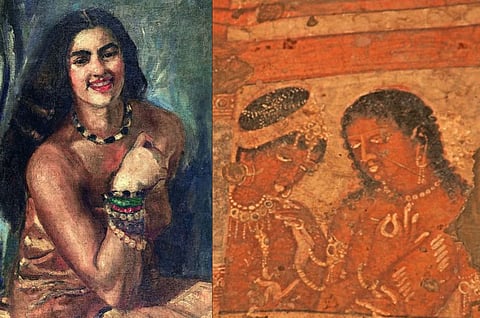
- HOMEGROWN WORLD
- #HGCREATORS
- #HGEXPLORE
- #HGVOICES
- #HGSHOP
- CAREERS
- ABOUT US
- CONTACT US

"The erotic is a measure between the beginnings of our sense, of self and the chaos of our strongest feelings."
- Audre Lorde (The Uses of the Erotic)
Through the lore of myth and fiction, India has always explored the realms of desire. Prior to the present day conservatism we were unhindered beings who openly discussed the matters of sexuality, especially in the context of female exploration. This is because we revered the fundamental energy that moves through our bodies, instead of being ashamed of it. These expressions were duly noted in art throughout ancient history, as we became the pioneers of sensual exploration.
Our artists have for long have captured the beauty of female desire through an almost ‘sacred’ lens. Devoid of blatant objectification, these works of art demanded reverence and admiration. The pieces have existed in different periods when they were either idealised in temples or degraded for an unabashed feminist perspective. Although creatives have continued to present their visions irrespective of either of these reactions.
Renowned historian William Darlymple, derives interesting conclusions in his story for BBC, “A Point of View: The sacred and sensuous in Indian art”. Discussing how as opposed to the west’s perspective of viewing the body as essentially sinful, lustful and shameful, Indian art from the early ages have glorified the same. Darylmple suggests that the imagery on many of the ancient murals that show women and dancing girls, some of whom are nude, would generate havoc in the west.
The Ajanta paintings and sculptures are a testament to this fact, these works are the most famous in the history of Indian art. They portray the women as ‘voluptuous temptresses’, stressing in the fertility aspect through their ample curves. This trend is further elaborated in the Mauryan, Buddhist art style where women's prominent sensuality was not perceived as a threat. According to the Allahabad Museum, if women were ever depicted as having power it was always in the sexual sense as seen in the sculptures of the women in Khajuraho frescos that are assured and supremely confident in their sexuality.
Erotic sculptures are also found adorning the walls of the temples of Somnathapura, Halebid and Modhera, among others. The subjects of these sculptures were mostly women framed in a dynamic light as their desires were captured by the creators in the most subtle and positive ways. As a writer at Scroll explains that these creations were ‘liberation carved in stone’. Initial sculptures showed them holding hands or embracing their lovers, but with the passage of time, the imagery grew bolder.
We are well aware of the changes in the Indian psyche over the course of different invasions. As these difficult periods have forever limited our view of women’s sexuality and desire. However the hero of Indian modernism, Amrita Shergill challenged these perspectives through her ‘unorthodox’ style. Her rebellious creations dignified a woman’s right to desire as she framed their experiences of exploration in a powerful context. Hugely inspired by Western renaissance and the Ajanta caves, she explained the context of feminine desire in her work as “a sensuality so great that it overflows the boundaries of the mere physical”.
A lot of Shergill’s work involved nudity and she inspired feelings of discomfort in a relatively close minded society. The artist saw her own body as a subject too, and her self portraits were a result of this. Painted with a 'risque predeposition', the artwork captured her hidden sexuality that was channelled through art in an almost spiritual sense. Declaring ownership over her own body, desire and womanhood, Shergill enunciated the feelings of so many women of her time. Emerging as a feminist icon revered for her contributions to the movement to this day.
At present artists like Indu Harikumar are creating powered art projects on sexuality, desire and belonging. Presenting her own experiences as well as of so many other Indian women through a compilation of digital art named ‘sexperiences’. Similarly in the realms of art photography legendary artist Prabuddha Dasgupta framed the bold and raw desires of women in his black and white portraits. Beyond lustful perceptions these creations were tasteful explorations of femininity and the body that oftentimes challenged society's double standards.
Through the course of Indian history art has projected the multilayered experiences of women that remained starkly different from the usual media portrayals. Whether it be in the ancient temple sculpture, in the modernist period or through contemporary imagery, the non-conformist spirit has always been alive. These depictions gracefully sculpted the female experience through which women could derive a sense of dignity as well as explore their sexuality. The artists centred their work around femininity to continually question our puritanical standards and in the process glorified the experience of female desire.
